Get a detailed overview of the risks and resilience of India’s financial system highlighted in the RBI’s Financial Stability Report December 2022. This report includes a collective assessment from the FSDC on financial stability and an update on key indicators like asset quality and stress test results. Find out more about the latest findings and their implications for the Indian economy with our summary of the RBI’s Financial Stability Report for December 2022.
Key Points of RBI’s Financial Stability Report December 2022
- The global economy is facing significant challenges and recessionary risks, while the Indian economy is showing resilience due to strong macroeconomic fundamentals and healthy financial sector balance sheets.
- Demand for bank credit is strong and there are early signs of a revival in the investment cycle, partly due to improved asset quality and strong capital and liquidity buffers at scheduled commercial banks (SCBs).
- The gross non-performing asset (GNPA) ratio of SCBs has fallen to a seven-year low of 5.0%, and net non-performing assets (NNPA) have dropped to a ten-year low of 1.3% in September 2022.
- Macro stress tests for credit risk reveal that SCBs would be able to meet minimum capital requirements even under severe stress scenarios.
- Stress tests for open-ended debt mutual funds show no breaches in limits related to interest rate, credit, and liquidity risks.
- The consolidated solvency ratios of both life and non-life insurance companies remain above the prescribed minimum levels.
Global Headwinds Hit Indian Economy, But Strong Fundamentals Provide Resilience
The global economy is facing significant challenges and recessionary risks, according to the RBI’s Financial Stability Report December 2022. Despite these global headwinds, the Indian economy is showing resilience due to strong macroeconomic fundamentals and healthy financial sector balance sheets. This is reflected in indicators such as improved asset quality and strong capital and liquidity buffers at scheduled commercial banks (SCBs).
Also Read: RBI’s Monthly Bulletin January 2024
SCB Asset Quality Improves, Stress Tests Show Ability to Meet Capital Requirements
Scheduled commercial banks (SCBs) in India have seen an improvement in asset quality, with the gross non-performing asset (GNPA) ratio falling to a seven-year low of 5.0% in September 2022. This is accompanied by a drop in net non-performing assets (NNPA) to a ten-year low of 1.3%. These positive trends may indicate a return to profitability for SCBs and are likely a result of strong capital and liquidity buffers.
In addition to the improvement in asset quality, the RBI’s Financial Stability Report December 2022 found that SCBs would be able to meet minimum capital requirements even under severe stress scenarios. This is according to the results of macro stress tests for credit risk. These tests simulate the impact of hypothetical stress events on the financial system and help to ensure that institutions are prepared to withstand potential shocks.
Overall, the findings of the RBI’s Financial Stability Report December 2022 suggest that SCBs are well-positioned to handle potential risks and maintain financial stability. The improvement in asset quality and the ability to meet capital requirements under stress scenarios are both positive indicators for the financial system.
Debt Mutual Funds Pass Stress Tests, Insurance Solvency Ratios Remain Strong
According to the RBI’s Financial Stability Report December 2022, open-ended debt mutual funds in India have successfully passed stress tests for interest rate, credit, and liquidity risks. These stress tests are designed to evaluate the ability of financial institutions to withstand potential shocks and ensure that they are prepared for a range of scenarios. The fact that open-ended debt mutual funds passed these tests is a positive indicator for financial stability in the country.
The RRBI’s Financial Stability Report December 2022 also found that the consolidated solvency ratios of both life and non-life insurance companies in India remain above the prescribed minimum levels. This means that these institutions have a sufficient level of capital to cover the risks they take on and to meet their financial obligations. Maintaining strong solvency ratios is important for the stability of the insurance sector and the financial system as a whole.
Low NNPA Ratio Reflects Improved Asset Quality at Scheduled Commercial Banks
The net non-performing asset (NNPA) ratio of scheduled commercial banks (SCBs) in India has fallen to a ten-year low of 1.3% in September 2022, according to the RBI’s Financial Stability Report December 2022. This low NNPA ratio is a reflection of improved asset quality at SCBs and may indicate a return to profitability. Asset quality is an important factor in the health and stability of financial institutions, and the improvement in this area is a positive sign for the financial system.
FSR Highlights: Risk to Financial Stability and Resilience of Indian Financial System
The RBI’s Financial Stability Report December 2022 provides an assessment of the risks to financial stability and the resilience of the Indian financial system. The FSR looks at a range of factors that can impact financial stability, including the health of financial institutions, the performance of the economy, and the state of financial markets.
The FSR found that the global economy is facing significant challenges and recessionary risks, while the Indian economy is showing resilience due to strong macroeconomic fundamentals and healthy financial sector balance sheets. This is reflected in indicators such as the low gross non-performing asset (GNPA) ratio of scheduled commercial banks (SCBs) and the strong capital and liquidity buffers at these institutions.
Also Read:
